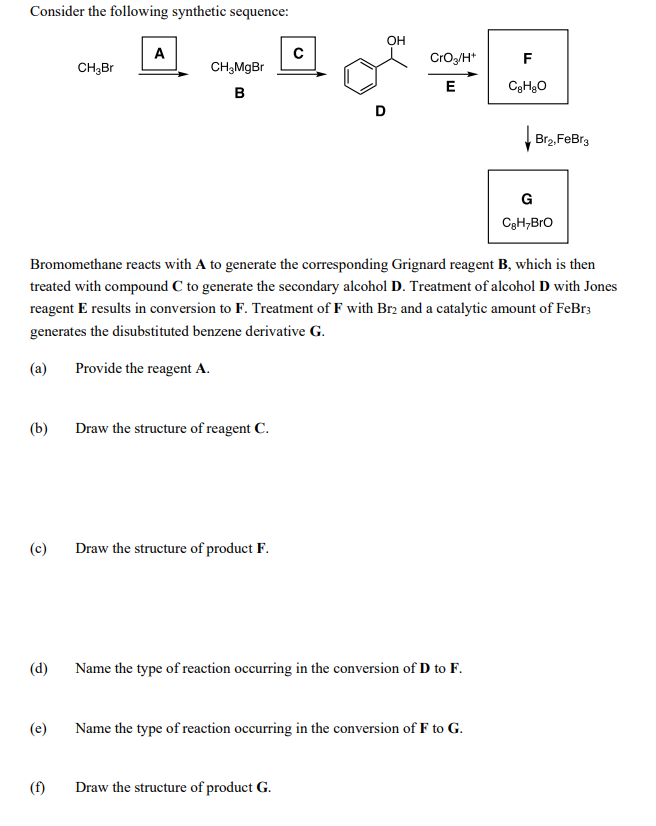Consider the following synthetic sequence: он A Cro/H* F CH;Br CH,MgBr E в Br2.FeBr3 G C3H,Bro Bromomethane reacts with A to generate the corresponding Grignard reagent B, which is then treated with compound C to generate the secondary alcohol D. Treatment of alcohol D with Jones reagent E results in conversion to F. Treatment of F with Br2 and a catalytic amount of FeBr3 generates the disubstituted benzene derivative G. (a) Provide the reagent A. (b) Draw the structure of reagent C. (c) Draw the structure of product F. (d) Name the type of reaction occurring in the conversion of D to F. (e) Name the type of reaction occurring in the conversion of F to G. (f) Draw the structure of product G.
Consider the following synthetic sequence: он A Cro/H* F CH;Br CH,MgBr E в Br2.FeBr3 G C3H,Bro Bromomethane reacts with A to generate the corresponding Grignard reagent B, which is then treated with compound C to generate the secondary alcohol D. Treatment of alcohol D with Jones reagent E results in conversion to F. Treatment of F with Br2 and a catalytic amount of FeBr3 generates the disubstituted benzene derivative G. (a) Provide the reagent A. (b) Draw the structure of reagent C. (c) Draw the structure of product F. (d) Name the type of reaction occurring in the conversion of D to F. (e) Name the type of reaction occurring in the conversion of F to G. (f) Draw the structure of product G.
Organic Chemistry
8th Edition
ISBN:9781305580350
Author:William H. Brown, Brent L. Iverson, Eric Anslyn, Christopher S. Foote
Publisher:William H. Brown, Brent L. Iverson, Eric Anslyn, Christopher S. Foote
Chapter10: Alcohols
Section: Chapter Questions
Problem 10.44P
Related questions
Concept explainers
Organomagnesium compounds
The interaction of alkyl halide with Mg metal in a suitable ether solvent is the common method for the synthesis of the Grignard reagent.
Hydrolysis Grignard Reactions and Reduction
Organomagnesium halides are Grignard reagents. Francois Auguste Victor Grignard, a French chemist who received the Nobel Prize in Chemistry in 1912, created these highly useful reagents.
Question

Transcribed Image Text:Consider the following synthetic sequence:
OH
A
CrOg/H*
F
CH3BR
CH,MgBr
E
B
Br2, FeBr3
G
CgH,Bro
Bromomethane reacts with A to generate the corresponding Grignard reagent B, which is then
treated with compound C to generate the secondary alcohol D. Treatment of alcohol D with Jones
reagent E results in conversion to F. Treatment of F with Br2 and a catalytic amount of FeBr3
generates the disubstituted benzene derivative G.
(a)
Provide the reagent A.
(b)
Draw the structure of reagent C.
(c)
Draw the structure of product F.
(d)
Name the type of reaction occurring in the conversion of D to F.
(e)
Name the type of reaction occurring in the conversion of F to G.
(f)
Draw the structure of product G.
Expert Solution
This question has been solved!
Explore an expertly crafted, step-by-step solution for a thorough understanding of key concepts.
This is a popular solution!
Trending now
This is a popular solution!
Step by step
Solved in 4 steps with 4 images

Knowledge Booster
Learn more about
Need a deep-dive on the concept behind this application? Look no further. Learn more about this topic, chemistry and related others by exploring similar questions and additional content below.Recommended textbooks for you

Organic Chemistry
Chemistry
ISBN:
9781305580350
Author:
William H. Brown, Brent L. Iverson, Eric Anslyn, Christopher S. Foote
Publisher:
Cengage Learning

Organic Chemistry
Chemistry
ISBN:
9781305580350
Author:
William H. Brown, Brent L. Iverson, Eric Anslyn, Christopher S. Foote
Publisher:
Cengage Learning